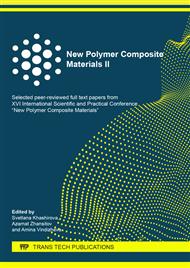p.449
p.456
p.466
p.474
p.481
p.488
p.494
p.501
p.508
Influence of Concentration of Carbon and Glass Fibers, Melt Viscosity, and Number of Extrusions on the Porosity of Composites Based on Polyphenylene Sulphone, Polyethyrimide and Polyphenylene Sulfide
Abstract:
A comparative analysis of the effect on the porosity of composite filaments based on polyphenylene sulfone, polyetherimide and polyphenylene sulfide with discrete fibrous fillers, such factors as the filler concentration, melt viscosity and number of extrusion passes, was carried out. It is shown that with increasing filler content and decreasing melt viscosity, the porosity of composite filaments enhances. Upon repeated extrusion carbon-filled composites, a decrease in porosity is observed, however for glass-filled samples an increase in porosity is occurred. A comparative analysis showed that the filament samples based on polyetherimide have a higher porosity. The most resistant to pore formation are polyphenylene sulfone-based samples.
Info:
Periodical:
Pages:
481-487
Citation:
Online since:
October 2020
Price:
Сopyright:
© 2020 Trans Tech Publications Ltd. All Rights Reserved
Share:
Citation:


